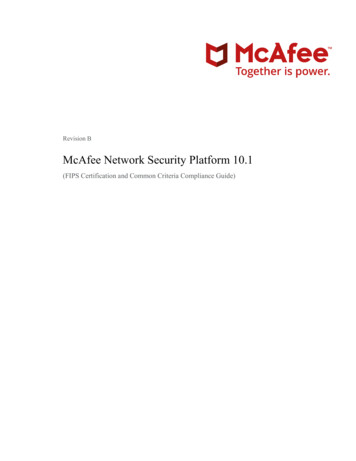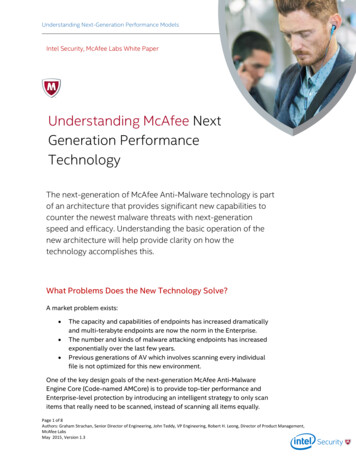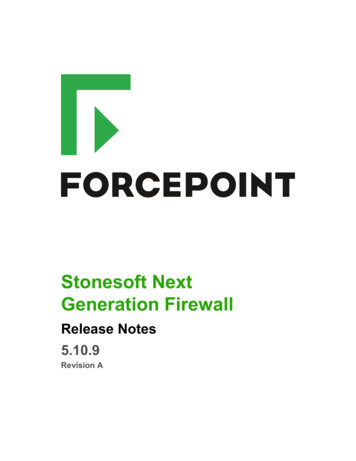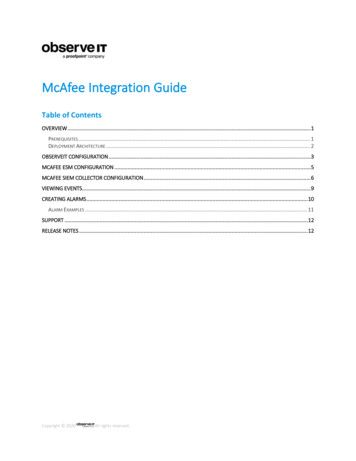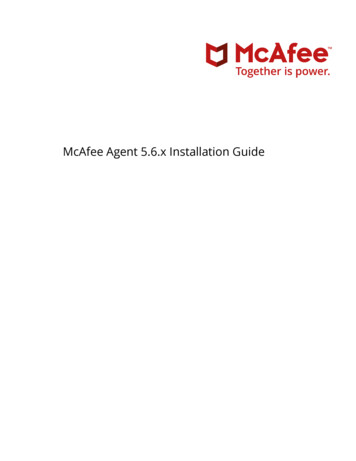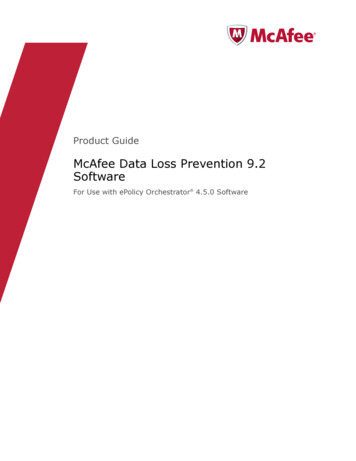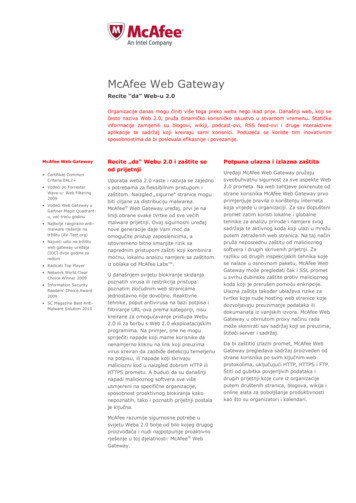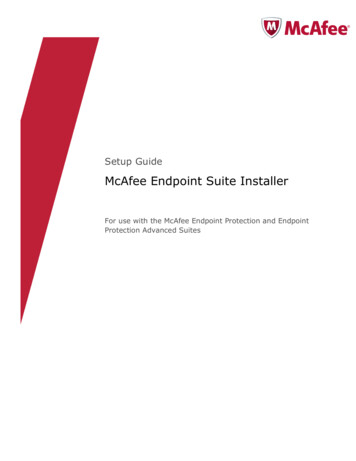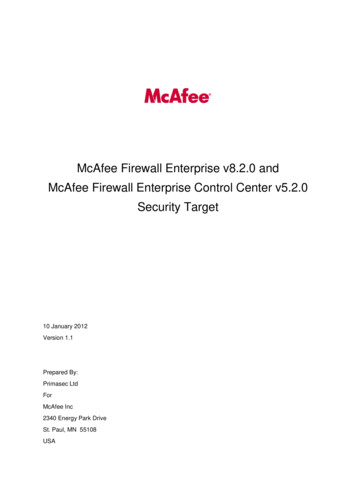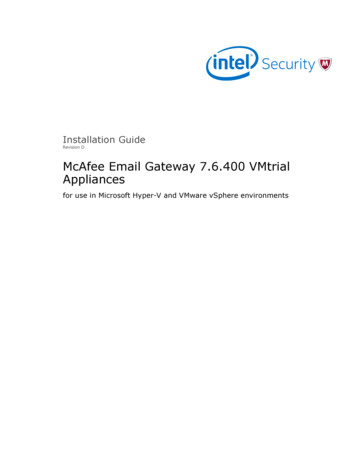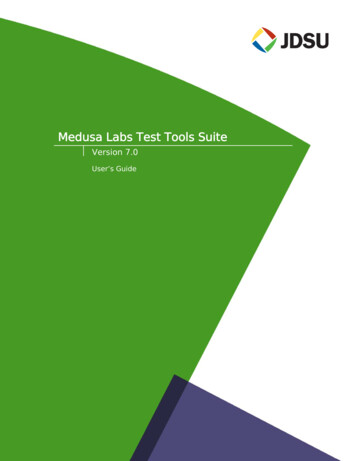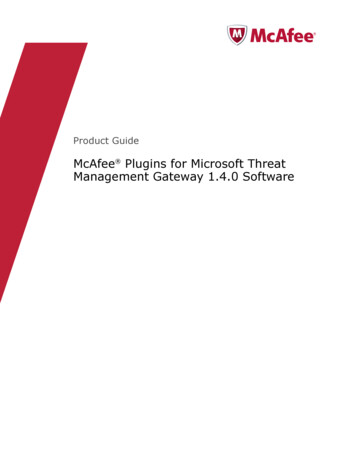
Transcription
McAfee LabsThreats ReportApril 2017REPORT
The Mirai botnet exploited poorly secured IoTdevices to perform the largest ever distributeddenial-of-service attack.About McAfee LabsIntroductionMcAfee Labs is one of the world’s leading sources forthreat research, threat intelligence, and cybersecuritythought leadership. With data from millions of sensorsacross key threats vectors—file, web, message, andnetwork—McAfee Labs delivers real-time threatintelligence, critical analysis, and expert thinking toimprove protection and reduce risks.What a winter we have experienced in the world Follow McAfee Labs BlogFollow McAfee Labs TwitterLast fall, cybersecurity crossed into political territory ina major way. In the United States, there were attackson entities associated with both major political parties,apparently in an attempt to influence the US presidentialelection. The issue also made it into a debate in thatelection, too, with one moderator asking “Our institutionsare under cyberattack, and our secrets are being stolen. Somy question is, who’s behind it? And how do we fight it?”We also saw the first major attack to leverage poor securityof Internet of Things (IoT) devices last fall. The so-calledDyn attack was a distributed denial of service (DDoS)attack that used IoT devices as bots to cripple a major DNSservice provider. At its peak, the Dyn attack generated1.2Tbps of traffic, effectively shutting down many wellknown websites. In this Threats Report, we analyze theMirai malware, which was at the heart of that attack.The coupling of the importance of cybersecurity in afunctioning democracy with the growing awareness ofweaknesses in internet and critical infrastructure securitymakes it clear that cybersecurity has indeed become amajor geopolitical topic.McAfee Labs Threats Report, April 2017 2
Just before the holidays, we held two webcasts on topicsfamiliar to regular readers of McAfee Labs ThreatsReports. On December 14, 2016, a panel of seven of ourthreats researchers discussed our top threats predictionsfor 2017 and beyond. You can watch the replay of thepredictions webcast, and read the McAfee Labs 2017Threats Predictions report.A day later, a panel of our experts discussed theevolution of security operations centers (SOCs). Thiswebcast coincided with the publication of the McAfeeLabs Threats Report: December 2016, in which wedetailed survey results from a primary research study onthe past, present, and future of SOCs. Watch the replayof the SOC webcast.Last month, we released the report Building Trust in aCloudy Sky, which details results from our annual surveyabout the state of cloud adoption. While trust in thecloud has continued to increase, we also discovered thatalmost half of those surveyed have slowed their cloudadoption due to a lack of cybersecurity skills.And finally, we were quite active at the RSA Conference2017 in San Francisco. In addition to several productannouncements, we announced with our partnersthe incorporation of the Cyber Threat Alliance. TheCTA was established in 2014 as a threat intelligencesharing consortium of IT security vendors. With thisincorporation, the cofounding members—Intel Security(now McAfee), Symantec, Palo Alto Networks, Fortinet,Cisco, and Check Point—are now fully committed to thesuccess of the CTA.The CTA also announced a platform to automaticallyshare and score threat intelligence among CTAmembers. This platform organizes and structures threatinformation through “Adversary Playbooks.” It providesa way for CTA members to automatically ingest andpropagate actionable threat intelligence to better protectcustomers. We now use CTA data to improve protectionand detection effectiveness across our threat defenselifecycle solutions.In this quarterly Threats Report, we highlight twoKey Topics: We discuss the background and drivers ofthreat intelligence sharing; various threatintelligence components, sources, and sharingmodels; how mature security operations canuse shared threat intelligence; and five criticalthreat intelligence–sharing challenges thatneed to be overcome.We examine Mirai, which was responsible forthe widely publicized DDoS attack on Dyn, amajor DNS service provider. Mirai is notablebecause it detects and infects poorly securedIoT devices, transforming them into bots toattack its targets.These two Key Topics are followed by an enhancedset of quarterly threat statistics. New this quarter areseveral charts that summarize incident activity duringthe period. We gather data from public sources, ourFoundstone Services incident response team, and fromour threat research team to create the picture. Incidentinformation is presented over time, by industry sectorsand geographies. Let us know what you think.Share this ReportMcAfee Labs Threats Report, April 2017 3
And in other news In December, as part of our dynamic Endpoint Protectionsolution, McAfee Labs released Real Protect. Thistechnology detects zero-day malware in near real time,using cloud-based machine learning to automate theclassification of suspect malware on the endpoint,based on behavioral and static analysis. We also recentlylaunched McAfee Cloud Threat Detection, which canbe used with our web security products and McAfeeNetwork Security Platform. This technology leveragescloud-based machine learning and other groupclassification methods to identify unknown malwaresubmitted to our cloud and produce analysis reports andindicators of compromise. These are some of the excitingnew protection technologies, using machine learningand big data analytics, that power our next generation ofprotection and intelligence solutions.Every quarter, we discover new things from the telemetrythat flows into McAfee Global Threat Intelligence. TheMcAfee GTI cloud dashboard allows us to see andanalyze real-world attack patterns that lead to bettercustomer protection. This information provides insightinto attack volumes that our customers experience. InQ4, our customers saw the following attack volumes: Just before the RSA Conference 2017 last month, we wentlive with enhancements to the McAfee Threat Center.We now provide a “Threat Landscape Dashboard,” whichlists the top threats in several categories, includingexploit kits, campaigns, ransomware, and vulnerabilities.The dashboard details which threats are significant,their common behaviors, and steps that can be takento mitigate them. We believe that increased threatawareness leads to better protection. We hope you like it. McAfee GTI received on average 49.6 billionqueries per day in Q4.McAfee GTI protections against maliciousURLs increased to 66 million per day in Q4from 57 million per day in Q3.McAfee GTI protections against maliciousfiles decreased to 71 million per day in Q4from 150 million per day in Q3 due to greaterdownload blocking.McAfee GTI protections against potentiallyunwanted programs showed an increase to37 million per day in Q4 from 32 million perday in Q3.McAfee GTI protections against risky IPaddresses showed an increase to 35 millionper day in Q4 from 27 million per day in Q3.Have a wonderful spring.—Vincent Weafer, Vice President, McAfee LabsShare this ReportMcAfee Labs Threats Report, April 2017 4
ContentsMcAfee Labs Threats ReportApril 2017This report was researched andwritten by:Christiaan BeekDouglas FrosstPaula GreveYashashree GundFrancisca MorenoEric PetersonCraig SchmugarRick SimonDan SommerBing SunRavikant TiwariVincent WeaferExecutive Summary6Key Topics7Threat intelligence sharing: What you don’t knowcan hurt youMirai, the IoT botnetThreats Statistics81635
Executive SummaryThreat intelligence sharing: What you don’t know can hurt youSharing threat intelligencesignificantly reduces attackers’advantages, making their effortsless profitable and shortening theeffective lifecycle of campaigns.Historical barriers to sharing aredropping as the legal frameworkis updated, data standardsfor interoperability emerge,sharing is automated, and threatintelligence-sharing organizationsare established.Threat intelligence sharing promises to improve our ability to protectassets and detect threats. This Key Topic provides a detailed analysis ofthe background and drivers of threat intelligence sharing, the variouscomponents of threat intelligence and its sources, how mature securityoperations can use this information, five critical challenges that need tobe overcome, and the evolving sharing models that have appeared inthe market.To move threat intelligence sharing to the next level of efficiency andeffectiveness, we see three areas for improvement: We need to simplify event triage and provide a better environmentfor security practitioners to investigate high-priority threats.We need to do a better job establishing relationships betweenindicators of compromise so that we can understand theirconnections to attack campaigns.We need a better way to share threat intelligence between our ownproducts and with other vendors.Mirai, the IoT botnetIoT devices are being hijackedand used to carry out seriouscrimes in cyberspace. Attackers,after gaining control of IoTdevices, can use them to attackbusiness, consumers, or internetinfrastructure. The Mirai botnet isjust the beginning.On October 21, 2016, the domain name service company Dyn was attackedwith a massive and complex distributed denial-of-service attack. At its peak,Dyn was flooded by 1.2Tbps of traffic, the highest volume of DDoS trafficever recorded. The analysis of the attack confirmed that the DDoS trafficoriginated from Internet of Things devices infected by the Mirai botnet.Also in October, the source code for Mirai was publicly released. This releasehas already led to derivative bots, although most appear to be driven byscript kiddies and are relatively limited in their impact. The source coderelease has also led to offerings of “DDoS-as-a-service” based on Mirai,making it simple for willing attackers to execute DDoS attacks that leverageother poorly secured IoT devices.In this Key Topic, we examine the Mirai botnet and its associated bots,including its architecture and inner workings; its attack process, including themany attack vectors it can use to flood targets; and its evolution.Share this ReportMcAfee Labs Threats Report, April 2017 6
Key TopicsThreat intelligence sharing: Whatyou don’t know can hurt youMirai, the IoT botnetShare feedback
Key TopicsThreat intelligence sharing: What youdon’t know can hurt you—Vincent WeaferIn a world of constantly changing technology, a world losing definedperimeters and clear areas of trust, traditional security models are underpressure. Increasingly sophisticated attackers are evading discrete defensesystems, and siloed systems let in threats that have been stopped elsewherebecause they do not share information.Effective security models must work in the new reality of determining accessprivileges to secure content from any device, by any user, at any time,from any location, based on multiple attributes that build a more completepicture of the context of the user and the request. Models must also detectand correct evolving threats, from common malware to ransomware, zeroday exploits, and advanced campaigns that use sophisticated planning andtechnical tools. Although we are improving various security technologies towork more effectively in this new environment, only by sharing intelligenceamong devices and organizations can we gain the advantage againstour adversaries.In this Key Topic, we discuss the background and drivers of threat intelligencesharing, the various components of threat intelligence and its sources, thesharing models that have appeared in the market, and five critical challengesthat we need to overcome. To move threat intelligence sharing to the nextlevel of efficiency and effectiveness, we need to focus on three areas: We need to simplify event triage and provide a better environmentfor security practitioners to investigate high-priority threats.We need to do a better job establishing relationships betweenindicators of compromise so that we can understand theirconnections to attack campaigns.We need a better way to share threat intelligence between our ownproducts and with other vendors.Why expand threat intelligence sharing now?Threat intelligence sharing has been around for a long time, driven by securityresearchers, vendors, and government agencies. Various vertical industrygroups have also created intelligence centers for sharing some informationabout threats targeting their members. This has been a slow and manualprocess, constrained by publishing calendars, research agendas, and thedesire to maximize publicity. Organizations have generally been reluctantto share even the barest details on attacks or compromised systems, in fearof litigation, reputational damage, or publicizing unpatched vulnerabilities.We detailed survey results revealing attitudes and concerns about threatintelligence sharing in the Key Topic “The rise of cyber threat intelligencesharing” in the March 2016 edition of the McAfee Labs Threats Report.Share this ReportMcAfee Labs Threats Report, April 2017 8
Key TopicsThe growing complexity of the technology environment is a very importantdriver for sharing threat intelligence. Applications, devices, and clouds haveenabled anytime, anywhere, anything access demands, making it difficultto distinguish between legitimate and suspicious traffic. Attackers can alsocome from anywhere at any time, can be highly informed about their targets,and can rapidly adapt to changing circumstances. As a result, we need toknow much more about both attacker and target, and better understand therelationships between bits of data to protect the environment.Further, the growing number and increasing sophistication of attackers hasbecome more and more overwhelming. An entire industry has grown tosupport these attackers, including subcontractors that can assist in any stepof an attack, from malware suppliers to as-a-service providers, from target-listvendors to money launderers. Some feel that legions of “orcs” have gained theupper hand.Many organizations are coming to realize that the benefits of sharingintelligence now outweigh the disadvantages. The volume and frequencyof attacks is so high that anyone and everyone are potential targets, andperhaps the most effective way to contain new attacks is to quickly sharetimely, contextually rich, machine-readable threat intelligence.What is threat intelligence?There are three forms of threat intelligence: tactical, operational, and strategicinformation. Tactical intelligence is the information gathered by securitysystems, scanners, and sensors. Most of this is automated, butis sometimes not communicated or lacks detail. For example,endpoint antivirus systems can detect and block a maliciousfile, but do not usually provide contextual data such as sourceIP addresses to decision support systems. This richer trace datawould enable centralized systems to identify structural elementsthat persist through an attack and correlate this info with otherdata. From a preventive standpoint, the information gatheredby these systems are often indicators of compromise, useful forforensic work and remediation efforts, but not detailed or sharedquickly enough to protect the entire organization.Operational intelligence encompasses the critical componentsfor establishing context. Security analysts spend the majority oftheir time trying to determine which events and alerts should beinvestigated, the scope and extent of a suspected attack, and howbest to coordinate the incident response actions. Too much of thisactivity is manual, often taking too long to prevent an infiltration orbreach. Big data analytics, machine learning, and other automateddecision-making techniques are being applied to this problemto augment human capacity and judgment, with the goal ofreducing response times and increasing the effectiveness of threatdetection and correction.Share this ReportMcAfee Labs Threats Report, April 2017 9
Key Topics Strategic intelligence is processed information that informssecurity policy and planning activities at the organizational level.This includes elements such as the most likely adversaries andtheir targets, risk probabilities and impact assessments, andregulatory or legal obligations. Although strategic intelligenceis largely a manual and experience-driven activity, up-to-datepolicies, plans, and risk profiles enable faster and more effectiveresponses to suspicious or malicious activities. The net effect isan overall framework of the current cyber threat environment,enhanced by contextual information about specific attacks andthreats. This information provides guidance and direction whenspecific tactics and indicators are detected.What Is Threat Intelligence?What threats shouldI look for on mynetworks and systems,and why?What activityare we seeing?ObservableIndicatorWhere has this threatbeen seen?What does it do?ProceduresIncidentWhat weaknesses doesthis threat exploit?Why does it do this?CampaignExploit TargetWho is responsiblefor this threat?What can I doabout it?Courseof ActionLoremThreat ActorModels of threat intelligence sharingA variety of threat intelligence-sharing models are already in use, somedating back more than 20 years. Others are evolving to adapt to the changingthreat landscape and some are still emerging—as law enforcement, securityvendors, government departments, and targeted organizations explore howto effectively share information and respond to the changing regulatoryenvironment.Share this ReportMcAfee Labs Threats Report, April 2017 10
Key TopicsInformation sharing and analysis centers (ISACs)These are nonprofit organizations that act as centralized collection pointsand clearing houses for cyber threat intelligence between federal, state, andlocal governments and specific industry verticals and critical infrastructuresectors. Many of these began as a result of a US presidential directive in 1998encouraging the sharing of threat information and vulnerabilities betweencritical infrastructure owners and operators. Although initially focused on USinfrastructure, many ISACs have expanded their coverage to include membersfrom around the world. ISACs have also been formed in industries beyondcritical infrastructure. Current ISACs serve automotive, aviation, electricity,retail, financial services, nuclear, and water industries, among others.Information sharing and analysis organizations (ISAOs)These are more broadly defined than ISACs, as an additional mechanism toencourage and support threat intelligence sharing. Encouraged by a US lawpassed in 2015 that limited legal liability for sharing threat intelligence withother companies, these organizations can be private or nonprofit, focusedon a specific threat or region, and range from communities of interest togovernment agencies to fee-for-service companies.Computer emergency response teams (CERTs) and incident responseteams (IRTs)Hundreds of IRTs span the globe. The oldest and best known of these is theCERT at Carnegie Mellon University, in Pittsburgh, established in 1998 at thedirection of the US Defense Advanced Research Projects Agency after theMorris worm incident. These organizations provide a range of functions,including threat and vulnerability research, development of some securitytools, and coordination of responses to identified threats and vulnerabilities.Most nations have a government-funded CERT or IRT, and most majortechnology companies operate one focused on their products.Threat exchanges: sharing for a feeThreat exchanges are an emerging phenomenon, ranging from for-profitorganizations to social network or crowdsourced operations. Like otherforms of threat intelligence sharing, these organizations are only as goodas their sources and their timeliness. Some multimember or crowdsourcedservices allow customers to select whom they will share with or rank thetrustworthiness of other members.Marketing: companies publish as a thought leaderSecurity vendors, technology companies, and other interested partiessometimes plan the release of threat intelligence for its marketing value, forexample, to enhance their status as thought leaders. There is a large andgrowing audience of security practitioners seeking threat reports and blogs.This interest is expanding to reach other interested parties as cyberattacksare increasingly part of the public consciousness. However, as a threatsharing model, reports are generally not up to date enough for tacticalprotection. Blogs, however, can be a timely and effective communicationmethod for threat intelligence sharing. Although blogs are not machinereadable, strategic intelligence is partially formed through this sharing of ideasamong practitioners, making these efforts a valuable part of the intelligencesharing model.Share this ReportMcAfee Labs Threats Report, April 2017 11
Key TopicsRevenue partnerships: commercial threat intelligence and securityvendorsVendor-operated intelligence exchanges offer the advantage of dedicatedteams investigating and validating threats.Critical challengesAutomated threat intelligence sharing is not new but it is still in its early years.During the past several years, the industry has invested in machine generationand machine consumption of tactical threat data. Most data consists of eventlogs and indicators of compromise such as file hashes, suspicious URLs, andIP addresses. These indicators are very time sensitive, and lose value almostimmediately. At the same time, the volume and quality of this data createsnew challenges. It is hard to identify high-quality, actionable indicators amongthe flood of information, making triage difficult for security analysts.Although the industry has built tactical intelligence-sharing capabilities,especially among each company’s own products, the industry still fails atsharing high-level, contextually rich intelligence, such as advanced campaigns,at a meaningful level and with other industry participants. Five criticalchallenges face security vendors and organizations that want to incorporatethis valuable intelligence into their security operations. They are volume,validation, quality, speed, and correlation.VolumeDuring the past few years, the deployment of enhanced and verbose securitysensors and defenses has resulted in a high volume of data fed into threatintelligence tools. Big data analytics and machine-learning tools consume thisdata and add their analyses to it. The net effect is an improvement in internalcapabilities to detect potential attacks and a marked increase in internalthreat detection, but a massive signal-to-noise problem remains to be solved.Although the systems are getting better at detection, we have not yet seena corresponding improvement in the capability of human analysts to triage,process, and act on the intelligence. Vendors are working on solutions toaddress this problem, from access monitors on sensitive data to sophisticatedsandboxes and traps that can resolve contextual clues about a potentialattack or suspicious event. Further automation and process orchestration isessential to augment human capacity.ValidationDisinformation and fake news are not new. Adversaries may file false threatreports to mislead or overwhelm threat intelligence systems. As a result, it isessential to validate the sources of shared threat intelligence, from both insideand outside the organization. Outside validation is perhaps the more obviousrequirement, ensuring that incoming threat intelligence is being sent bylegitimate sources and has not been tampered with in transit. This is typicallyaccomplished with encryption, hashes, and other methods of digitally signingcontent. Internal validation is a different problem, not so much validatingthe sources as analyzing and evaluating the content to determine if it is alegitimate attack or a noisy distraction to draw attention and resources awayfrom a quieter, stealthier threat.Share this ReportMcAfee Labs Threats Report, April 2017 12
Key TopicsQualityRelated to source validation is the quality of the information we share.Legitimate sources can send anything from definitive indicators of attack orcompromise to their entire event feed, which may be of little or no relevanceto the receiver. Although more threat intelligence is generally better, much ofit is duplicated, and too much low-quality intelligence is of little value. Manythreat exchanges are coming online, but they are only as good as their inputsand sensors. Vendors need to re-architect security sensors to capture andcommunicate richer trace data to help decision-support systems identify keystructural elements of a persistent attack. Filters, tags, and deduplicationare critical intake tasks to automate in order to increase the value of threatintelligence and make it actionable. An early, promising effort to improvethreat intelligence quality will come online in 2017 through the Cyber ThreatAlliance. Threat intelligence coming from CTA members will be automaticallyscored for its quality, and members will be able to draw out threat intelligenceonly if they have provided sufficient quality input.SpeedThe speed of transmission, or more accurately, the latency between a threatdetection and the reception of critical intelligence, is also an importantattribute. Intelligence received too late to prevent an attack is still valuable,but only for the cleanup process. This is one reason why open andstandardized communication protocols, designed and optimized for sharingthreat intelligence, are essential to successful threat intelligence operations.The propagation of attacks between systems happens within a minute or twoof a machine’s being compromised, so communications between sensors andsystems within the enterprise have to operate in near real time. Meanwhile,advanced persistent threats and sophisticated, targeted campaigns often goafter multiple organizations in the same vertical market, so communicationsfrom one organization to another, usually involving an intermediary orexchange, have to take place within a few hours of the first indication ofan attack.CorrelationFinally, as threat intelligence is received, correlating the information—whilelooking for patterns and key data points relevant to the organization—isthe most critical step. Although some organizations treat the raw data as aproprietary or competitive advantage, the ability to collect data is not a criticalfactor. It is the processing that turns data first into intelligence and then intoknowledge that can inform and direct the security operations teams. Theability to validate data in near real time, correlate it across multiple operatingsystems, devices, and networks, use it to triage the event, prioritize theinvestigation, and scope the response is critical to provide effective detectionand corrections actions. The goal is to leverage technologies and machinecapabilities to triage event data, distill it into high-quality events, and scopeand prioritize the incidents so that security analysts can focus their attentionon the highest-risk items.Together, these issues describe threat intelligence sharing’s “last mile”problem: taking this information and converting it to controlled action. Tocover this last mile we need to find better ways to share threat intelligencebetween a vendor’s products and with other vendors, improve methods toautomatically identify relationships between the intelligence collected, andemploy machine assistance to simplify triage.Share this ReportMcAfee Labs Threats Report, April 2017 13
Key TopicsIndicators sitting in a queue, inbox, or report may have arrived at theorganizations, but they are of no value until they are deployed into toolsthat can act on them. An overwhelming volume of threat data waiting to beprocessed by security analysts is of no value. Security operations across allindustries are throwing more and more technology and people at the problemof distilling signals from the noise, turning signals into prioritized incidents,and scoping and investigating those that pose the highest risk.More technology and resources will not solve the problem without a securityand data protection strategy in place. Too many organizations security teamshave little idea which pieces of data are the ones that are the most critical tothe mission or business, so they attempt a broad-brush approach to protecteverything. As the number of devices and the amount of data being generatedand stored increases by orders of magnitude, this overload will becomeunmanageable.It’s time to shareIt is critical to collect, triage, and validate data from many sources in nearreal time and use it to prioritize and scope events. Sharing threat intelligencesignificantly reduces attackers’ advantages, making their efforts less profitableand shortening the effective lifecycle of campaigns. Historical barriers tosharing are dropping as the legal framework is updated. For example, theCybersecurity Information Sharing Act offers liability protection to privatesector organizations and builds the legal foundation for sharing threatintelligence among private organizations and with the US government.In addition to the CISA, governments are encouraging and supporting the creationof information-sharing organizations to speed the collection and distribution ofthreat intelligence among communities of interest. To effectively use this data,open architectures for the collection and sharing of data are needed so that it istimely and actionable. Data standards for interoperability are emerging, but it isnecessary to build automation on top of these protocols that can validate andconsume the information at large scale and high speed. Intelligence marketplacesare also emerging, and need to be further enhanced to support and encouragethe exchange of information with measurable trust
Dyn attack was a distributed denial of service (DDoS) attack that used IoT devices as bots to cripple a major DNS service provider. At its peak, the Dyn attack generated 1.2Tbps of traffic, effectively shutting down many well-known websites. In this Threats Report, we analyze the Mirai malware, which was at the heart of that attack. The coupling of the importance of cybersecurity in a .
